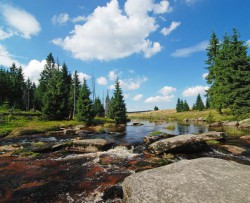 Jizera
Mountains are full of life. With
their mild hills, a network of trails and gravel roads, which are
also cycle routes, they are perfect for a family nature observation.
There are mane nature peculiarities in the Jizera, which are
difficult to come by in other regions of Poland or Europe.
Jizera
Mountains are full of life. With
their mild hills, a network of trails and gravel roads, which are
also cycle routes, they are perfect for a family nature observation.
There are mane nature peculiarities in the Jizera, which are
difficult to come by in other regions of Poland or Europe.
Persistent walkers or tourists, may spot the white-tailed eagle if they are lucky. In 2004, a nest of this magnificent and very rare bird has been found in Kamieniecki Ridge. You can also find the black stork in the beeches.
The Jizera are a frequently chosen touring destination not only for amateur scientists, but ornithologists as well, who come around to observe a true ornithological rarity – a population of grouse. These birds are nearly extinct, which is why they are subject to a protection program.

The forests in Jizera, usually dense over the slopes of these gentle yet mysterious mountains, often hold deer and roes, and in the Czech part, also fallow deer and boar. Small mammals, such as voles, bank voles, or mountain pygmy also find the conditions here comfortable.

Luckily, they did not succumb to human invasion, which makes them the refuge for the rarest and most interesting plant species. A rarity on the European scale is the dwarf birch (found in Poland in three locations only) drawn here from the far north by the glacier during the Ice Age.

 In
2000, the small (over 44.74ha) Jizera Peatbog Reserve was replaced
with a much larger Potbeag of Jizera Valley Reserve, with the area of
485ha. Moreover, it has been included in the European Ecological
Natura 2000 Network, and – together with the Czech reserves of
RAŠELINIŠTĚ IZERY, RYBÍ LOUKA, ČERNOU JEZÍRKA and RAŠELINIŠTĚ
JIZERKI – is part of an enormous natural complex – the most
precious in the whole Jizera Mountains.
In
2000, the small (over 44.74ha) Jizera Peatbog Reserve was replaced
with a much larger Potbeag of Jizera Valley Reserve, with the area of
485ha. Moreover, it has been included in the European Ecological
Natura 2000 Network, and – together with the Czech reserves of
RAŠELINIŠTĚ IZERY, RYBÍ LOUKA, ČERNOU JEZÍRKA and RAŠELINIŠTĚ
JIZERKI – is part of an enormous natural complex – the most
precious in the whole Jizera Mountains.
The poor grasslands in the Jizera and Mizerka valley, take a much smaller area than the peatbogs. A very important grassland complex near Górzyniec has been taken under protection within the KROKUSY Reserve, established in the 1960’s.
It is the location of crocus, very well-knowned in the Tatras. This is its only location in the Sudetes. The ecosystems here often contain reptiles: viviparous lizards and vipers.
A trip in Jizera Mountains is an invaluable lesson on nature, a chance to meet rare fauna and flora. It is a unforgettable adventure, both for the young and old explorers of the world of plants and animals, which is always at your fingertips in Jizera.
Based on an article by Arkadiusz Lipin
To
find out more on Jizera Mountains, visit www.goryizerskie.pl.
More
photos are found in a gallery by Zygmunt Trylański.











